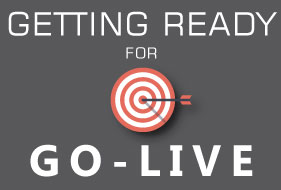
Written by Erica Niesse
This is the last installment in a 5 part series that will take you through everything you need to know when you’re implementing a workforce management system.
You’ve been through discovery, requirements gathering, configuration, and testing. Now, it is finally time to make the software you have spent months testing and critiquing available to your end users. The go live process is the final stretch of your marathon implementation, and although your implementation partner will be leading the way, your team will be an integral part of deploying the system and assisting with end user adoption. Shortly after this phase, your implementation partner will take a step back and your support transition will occur. To make this whole process smoother, it is helpful to understand how long your implementation partner will be engaged after the go live. We also recommend thinking about the transition to support months before the go live date, including creating a transition plan.
Here are a few key items to review when determining that you are ready to go live:
Go Live Readiness Plan:
Your project team will not wait until the go live phase of the project to start thinking about deploying the system. Go live considerations start weeks, if not months, before the actual go live. There are a number of items on your go live readiness plan to consider when determining if you are ready to go live. Most importantly, you will want to start by making sure that all User Acceptance Testing (UAT) items have been closed or addressed. This includes making sure that all defects that have been logged have been updated in the test environment and there is a migration plan to production. Prior to go live you will also want to prep your production data. This data should be sent to the test environment first to make sure the files are clean and ready for a production state.
This includes:
- All inbound files
- All outbound files
- All integrations with 3rd party systems
Your implementation partner will review these files and make sure that they are not causing any performance issues. If there are no issues, you can keep moving forward.
Go Live Checklist:
A go live checklist is a key component to a successful go live! The checklist should break down each of the steps that the customer and partner will go through in the deployment process. Reviewing this checklist ahead of time helps ensure you and your team understand what to expect during the go live phase.
The go live checklist should start with a Go-No Go decision. This typically takes the form of a meeting all that is setup between the implementation partner and the client (you!) to confirm that all issues were addressed in UAT and there are no concerns before beginning deployment to the production environment. The Go-No Go decision meeting should include stakeholders including:
- Project sponsors
- Project managers
- Subject matter experts
After the project team is given the go ahead to move forward, the go live checklist should be reviewed and remaining action items should be assigned to the team members, according to project roles. Beyond the Go-No Go decision, the checklist should include items such as:
- Preparation of the data files and enabling of the file paths
- Verification of email notifications
- Verification of user ability to log in
- Confirmation that all the policies have been migrated from the test environment to the production environment
Before your go live, don’t forget to set up a contact list, so that if there is an issue escalation, or an activity that needs to be addressed urgently, it is clear who to get in touch with to address these project needs. The contact list is especially important if a go live is occurring over the weekend, which is fairly common, since that timeline is less likely to be disruptive to normal business operations. If you are going live over a weekend, members from your team and your implementation partner’s team will need to be available over the weekend in the event that issues arise that need to be resolved urgently.
Now that you have the “go” decision approval, it is time to walk through the go live steps. The go live steps will typically occur a few days or weeks before the system go live to make sure that if any problems arise, the system deployment is not impacted.
When you start walking through the steps of a go live checklist, it helps to assign one person as the person who is responsible for updating the checklist on an ongoing basis. It is also helpful to have an email chain with all project team members where each member sends an email via that chain when their assigned steps/activities are completed. Once all the steps on the go live checklist are successfully completed, the production system is ready, which means end users can begin using the new system!
Prepare for End User Questions and Support:
Prior to the deployment of your new system, your end users should have received training on the functions they will utilize in the system. For example, the employees using a new Time & Attendance system will be clocking in/out, entering time off requests and submitting their time. Meanwhile, managers and system administrators will use the system to review those employee timesheets and paying employees based on time worked. Additionally, these managers and administrators also might be entering their own time and submitting their own time off requests. Depending on the role each person has within your company, they will have different access levels within the system and will see different features.
Regardless of user role, it is important that all end users have access to quick tips on how to assess different exceptions or functions of the system, like how to punch in/out for work as well as meals and transferring to other jobs. A one-page user guide detailing the basic processes relevant to large populations of end users would be beneficial to distribute. The more resources you have available to end users, the more you’ll cut down on volume of basic questions being sent to your internal team members at go live. Fewer questions leaves the team with more bandwidth to address other change management strategies, which positively impacts user adoption.
In lieu of distributing printed training materials, you could also setup a link on your internal SharePoint/file sharing site, giving access to the training guides and quick user guides.
Ultimately, there will be questions that the quick guides don’t answer, so it is important to set up a hotline or email address for end users to send questions to. The goal of the whole implementation project is to come away with a properly configured system with high end user adoption, setting your end users up for success. So, making these tools available for end users to answer their own questions, and an easy way to get access to any lingering questions will better set you up for smooth sailing post-implementation.
Transition to Vendor or Partner Support:
Now that you have set up a plan for your end users, you also need to identify where your administrators will go if they have questions or need system updates down the line. Your software vendor will set up a meeting about transitioning to support during which you’ll be presented with different support package options. The support package overview meeting will also cover where to go if you have performance issues, if the system is down, or if you need updates to your environment. Your company will need to identify the team members internally who will handle submitting support tickets and handling any escalations to the vendor and support network that you set in place. We recommend limiting the number of people designated as vendor liaisons to 3 or fewer people. This way the risk of multiple tickets being entered for the same issue is minimized, and the team of 3 liaisons is small enough that each member can be notified of ticket updates.
Whether HRchitect has handled your implementation from start to finish, or you are looking for a support network after go live, we are your ‘go to’ partner for managing your workforce management system for the long term. All of our clients are assigned a dedicated support specialist who will know the ins and outs of your configuration, and will be your go to person for all issues or updates you need handled. HRchitect offer multiple levels of ongoing support. Each level comes with access to our expert consulting team and our deep HCM technology systems knowledge.
* To learn more about other phases in a WFM implementation, see these additional blogs by Erica:
- Discovery Phase – the start of a successful Workforce Management (WFM) implementation
- Requirements Phase – The key in a successful WFM Implementation
- HCM Implementation Configuration Phase – Time to Build
- Testing phase- The Client’s role in an Implementation

Erica Niesse is the Director of Workforce Management Consulting Services at HRchitect. Erica has over 10 years of experience guiding clients through successful Workforce Management system implementations.

